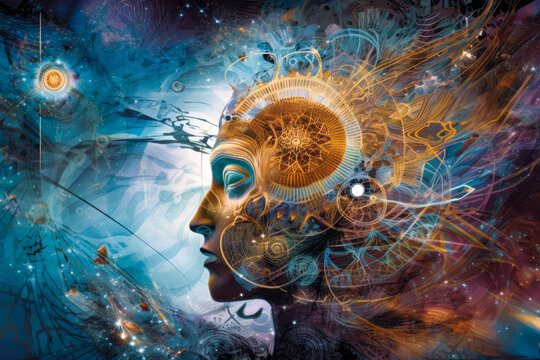The human mind is an enigma, a complex labyrinth of thoughts, emotions, and untapped potential. At the heart of this mystery lie two powerful entities: the conscious mind and the subconscious mind. Understanding these aspects of your mind is akin to holding a map to navigate your inner world, enabling you to harness their potential and transform your life. This article delves into the basics of what the conscious mind and subconscious mind are, explores the difference between conscious and subconscious mind, and unveils the profound power of conscious and subconscious mind.
What is Conscious Mind and Subconscious Mind:
The conscious mind is like the part of an iceberg you can see above the water. It’s all about what you’re aware of at this moment. When you’re thinking about what to eat, deciding on a movie to watch, or solving a math problem, you’re using your conscious mind. It’s in charge of things like making decisions, reasoning, and all the thoughts you’re actively focusing on.
The subconscious mind, on the other hand, is like the much larger part of the iceberg that’s hidden underwater. It holds all your past experiences, memories, emotions, and habits that you’re not actively thinking about right now. It’s working in the background, controlling the things you do automatically, like breathing and your heartbeat, without you having to think about them. It also influences your feelings and the decisions you make without you realizing it.
So, when we talk about “what is conscious mind and subconscious mind,” we’re looking at the conscious part as the controller of your immediate thoughts and actions, and the subconscious part as the deep, underlying force that shapes your feelings, reactions, and habits.
Difference Between Conscious and Subconscious Mind:

Firstly, the conscious mind is like the captain of a ship, aware and in control of what’s happening right now. It’s where you do all your thinking and planning. If you’re deciding what to wear, figuring out a puzzle, or just choosing what to eat, that’s your conscious mind at work. It deals with logic, reasoning, and the tasks you’re actively focusing on. In contrast, the subconscious mind is like the crew below deck, running things without the captain’s direct involvement. It stores all your memories, feelings, and learned habits. It controls the automatic stuff, like breathing and dreams, and influences your emotions and desires without you even realizing it. This is a major difference between conscious and subconscious mind.
Another difference between conscious and subconscious mind is in how they process information. The conscious mind processes one thing at a time, like reading a book or solving a math problem. Meanwhile, the subconscious mind can handle many tasks at once. It’s always on, even when you’re asleep, processing emotions, memories, and even solving problems in the background.
The third difference between conscious and subconscious mind lies in their impact on behavior. Your conscious mind makes choices based on current information and logical reasoning. But your subconscious mind has a more profound influence, guiding your behavior based on past experiences and deep-seated beliefs. Even when you think you’re making a conscious decision, it’s often your subconscious mind pulling the strings, based on patterns and learned behaviors from your past.
Understanding the difference between conscious and subconscious mind is crucial because it helps us see why we might act a certain way without thinking about it, or why changing habits can be hard. It’s a dance between the part of our mind we control and the part that controls us without us noticing. By learning about these differences, we can start to understand how to better influence our subconscious, align it with our conscious goals, and ultimately lead a more intentional and fulfilling life.
The Conscious Mind: The Gatekeeper of Your Thoughts
The conscious mind is your awareness at the present moment. It’s where you make decisions, think critically, and are aware of your environment. When you’re solving a math problem, deciding what to eat for dinner, or simply reading this article, you’re using your conscious mind. It processes thoughts, feelings, and actions that you are aware of and can control. The conscious mind is often compared to the tip of an iceberg, representing a small part of your mental capacity that’s visible and accessible.
The Subconscious Mind: The Hidden Force
Beneath the surface lies the subconscious mind, a vast and powerful entity that stores your beliefs, memories, experiences, and the countless pieces of information you’ve encountered throughout your life. It controls automatic functions like breathing and heart rate, influences emotions, and governs habits. The subconscious is the bedrock of your desires and fears, operating below the level of conscious awareness. It’s the scriptwriter of your dreams and the silent influencer of your daily decisions.
The interplay between the conscious and subconscious mind shapes your reality. The conscious mind sets goals, makes plans, and uses willpower, but it’s the subconscious mind that can often be the gatekeeper to achieving those goals. By aligning the power of conscious and subconscious mind, you can tap into a wellspring of creativity, motivation, and persistence.
Practical Steps to Bridge the Gap:
- Affirmations and Visualizations: Regularly affirming your goals and visualizing your success can program your subconscious to align with your conscious intentions, making it easier to achieve your objectives.
- Mindfulness and Meditation: These practices help you become more aware of your conscious thoughts and feelings and can be used to gently steer the subconscious in a desired direction.
- Repetitive Learning: The subconscious learns through repetition. Consistently feeding it positive thoughts and outcomes can reshape your beliefs and habits.
The Impact on Personal Development:
Understanding and working with both your conscious and subconscious mind can lead to profound personal development. It can enhance your ability to learn new skills, improve memory retention, increase creativity, and overcome fears or limiting beliefs. The conscious mind plans the seeds of success, but it’s the subconscious that nurtures these seeds to fruition.
The Scientific Basis:
Research in psychology and neuroscience has begun to uncover the intricate ways the conscious and subconscious mind interact. Studies using neuroimaging techniques like FMRI and EEG have shown how different parts of the brain are activated when engaging in tasks that require conscious thought versus those that tap into the subconscious. This scientific exploration underscores the potential of integrating the power of conscious and subconscious mind for emotional and psychological well-being.

